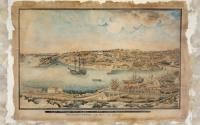Who was Jackson?
31 January 24
Sydney Harbour is acknowledged worldwide as one of the finer shipping facilities and sailing areas of inhabited nations.
Sailing through the Heads on a liner or flying over the Harbour before landing or taking off from Kingsford Smith airport gives another view of the dazzling waters and harbour frontages.
But the official name for the area is Port Jackson which raises the question of who was Jackson and what did he do.
The first recorded European discovery of Sydney Harbour was by Lieutenant James Cook in 1770. Cook named the inlet after Sir George Jackson, one of the Lord Commissioners of the British Admiralty and Judge Advocate of the Fleet
In his ship’s log a notation states: ‘at noon we were … about 2 or 3 miles from the land and abreast of a bay or harbour within there appeared to be a safe anchorage which I called Port Jackson.’
The land around Port Jackson was occupied at the time of the European arrival and colonisation by the Eora clans, including the Gadigal, Cammeraygal and Wangal. The Gadigal occupied the land stretching along the south side of Port Jackson from what is now South Head, in an arc west to the present Darling Harbour.
The Cammeragal lived on the northern side of the harbour. The area along the southern banks of the Parramatta River to Rosehill belonged to the Wangal. The Eora occupied Port Jackson (Sydney Harbour), south to the Georges River and west to Parramatta.
It was not until 18 years later, on 21 January 1788, that Governor Arthur Phillip after arriving at Botany Bay, took a longboat and two cutters up the coast to examine Cook’s Port Jackson. Phillip first stayed overnight at Camp Cove, then moved down the harbour, landing at Sydney Cove and then Manly Cove before returning to Botany Bay on the afternoon of 24 January.
He returned to Sydney Cove in HM Armed Tender Supply on 26 January 1788, where he established the first colony in Australia, later to become the city of Sydney. In his first dispatch from the colony back to England on 15 May 1788, Governor Phillip noted that:
‘… we had the satisfaction of finding the finest harbour in the world, in which a thousand sail of the line may ride in the most perfect security …’
Sir George Jackson Duckett, 1st Baronet, was born on 24 October 1725 and died on 22 December 1822 at the age of 97. He was a British naval administrator and a politician and was created a Baronet in 1791.
He was born George Jackson, probably in Yorkshire, the third but oldest surviving son of George Jackson (1687/8–1758) of Hill House, Richmond, Yorkshire, and Ellerton Abbey, Yorkshire, and Hannah, daughter of William Ward of Guisborough, Yorkshire. He sat as a Member of Parliament for Weymouth and Melcombe Regis from 1786–88, and for Colchester from 1790–96.
His political career was mixed and he seemed destined for a ministerial role until he lost his seat in 1789 to Whig opponent George Tierney. However, he regained Colchester in 1790 despite a petition by Tierney based on Jackson’s supposed disqualification as a pensioner when he had been awarded a yearly fee of 400 pounds after being dismissed as second secretary at the Admiralty in 1782. But this appeal was dismissed by the House.
Jackson made little impact during his last term in Parliament. He was reported hostile to the repeal of the Test Act in Scotland in 1791 and voted against the abolition of the slave trade. He failed in his effort to regain a seat in 1796.
He started his naval career as a clerk in the Navy office in June 1743 and became chief clerk in February 1775. His naval career continued when he was appointed Assistant Clerk of Acts in May 1758 and gained further promotion in 1766 when he was made Deputy Secretary to the Admiralty.
His biggest step forward came in 1768 with his appointment to the high position of Judge Advocate of the Fleet. In this capacity he was largely responsible for the conduct of the court martial of Admiral Lord Keppel in 1779 and the subsequent enquiry into the evidence of Sir Hugh Palliser. Jackson resigned from the Admiralty secretaryship in 1782 but remained Judge Advocate until his death.
He was a friend and patron of explorer Captain James Cook and in his honour, Cook named both Cape Jackson in New Zealand and Port Jackson in Sydney, Australia after his friend before Jackson took the name of Duckett.

Jackson married Mary Ward and they had three daughters. He later married Grace, daughter of George Duckett MP, with whom he had a son. In 1797, under the terms of the will of her uncle Thomas Duckett, Sir George assumed, by Royal Licence, the name and arms of that family, becoming Sir George Duckett, 1st Baronet. He was succeeded in the baronetcy by his son George (born 1777).
Thanks to his friendship with Captain Cook, Port Jackson, New South Wales and Point Jackson, New Zealand were named after him.
In two items of interest, the Great White Fleet, the United States Navy battle fleet, arrived in Port Jackson in August 1908 by order of US President Theodore Roosevelt. From 1938, seaplanes landed in Sydney Harbour on Rose Bay, making this Sydney’s first international airport.

Sir George Jackson Duckett,
1st Baronet, naval administrator
and politician.
Below - View of Sydney Port Jackson, New South Wales, taken from the Rocks on the western side of the Cove, ca. 1803 / drawn by John William Lancashireca. 1803
BY LANCASHIRE, JOHN WILLIAM, D. 1807?



